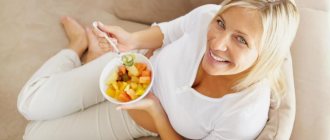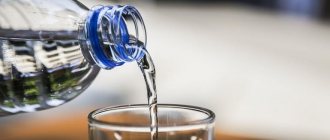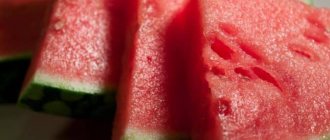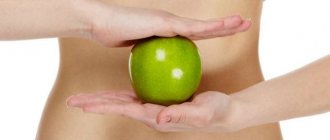Dietary table No. 5 is prescribed for diseases of the pancreas, liver, gall bladder and other organs of the digestive tract. The diet is based on increased consumption of protein foods while simultaneously limiting fats and carbohydrates. Purines, refractory fats, and coarse fiber are almost completely removed from the child’s menu.
For diseases of the digestive tract, therapeutic healthy nutrition according to dietary table No. 5 is prescribed in order to:
- normalize the functioning of the pancreas,
- prevent chemical and mechanical stress on the stomach or intestines,
- help the functioning of the gallbladder,
- prevent fatty infiltration of the pancreas or liver.
Who is prescribed
Table No. 5 is recommended for subacute normoacid gastritis, when the symptoms of the disease become less pronounced than in the acute phase. This diet is considered a priority in the following situations:
- the presence of concomitant pathology of the liver, pancreas, biliary tract;
- previous operations on the stomach (resection) and biliary tract (cholecystectomy);
- antral form of gastritis - inflammation of the stomach directly adjacent to the small intestine;
- Duadeno-gastric reflux is the backflow of the contents of the duodenum into the stomach.
In addition, the fifth table is used as a link between table No. 1 and general diet No. 15.
Note! In acute cases of the disease, it is recommended to prescribe tables No. 1a and No. 1b. For hyperacid inflammation, diet No. 1 is also more preferable. For hypoacid gastritis, diet No. 2 is more preferable.
In the subacute stage of normoacid inflammation of the stomach, when all symptoms lose intensity, table No. 5a is indicated. It is characterized by more stringent mechanical and thermal sparing of the gastric mucosa. Fat consumption is limited to 80 g, the daily calorie intake is on average 2550 kcal.
After the condition has stabilized, they switch to table No. 5. At the same time, the temperature regime expands somewhat, food no longer has to be crushed before consumption, and the energy value of the diet increases to 2800-3000 kcal/day. The permissible fat content in food increases slightly - up to 90 g.
Information. There is another modification of the fifth table - diet No. 5p. For gastritis, it is prescribed only if it is combined with pancreatitis. The diet is characterized by strict limitation of the consumption of extractives, refractory fats, cholesterol and sugar (up to 40 g).
The main features of the 5p treatment table
Since the diet of this diet should be gentle, it is quite limited in carbohydrates and fats. First of all, the diet consumes a minimum of sugar. You can consume no more than 30 grams of sugar per day, including everything that contains it.
Protein products can be consumed in larger quantities to gain the required amount per day: 100-120 grams of protein. Of this, half comes from animal protein. The norm for carbohydrates is 300-350 grams. This norm also includes sugar. 70 grams of fat, of which 15 grams are vegetable fats - this is how the therapeutic diet is limited. Calorie content of the daily diet – 2500 cal.
The amount of salt is also limited - up to 10 grams per day. In order to correctly calculate your daily allowance, you need to use a simple rule: add salt to ready-made dishes on your plate, and not during the cooking process. This way you can control the amount of salt you eat.
As with all therapeutic diets, the 5p diet for pancreatitis is, first of all, split meals - small meals every 2-3 hours. It is also important to adhere to the drinking regime and drink up to 1.5 liters of water per day every day, not counting the liquid in soups and compotes.
There are a significant number of restrictions in the 5p table diet. It is not allowed to eat fried, salted, pickled or canned food. Carbonated drinks, alcohol and strong black coffee are completely excluded.
Those products that cause chemical and mechanical irritation of the stomach, pancreas, and gall bladder are prohibited. In order to find out in more detail what is allowed and what is not allowed on the 5p dietary diet, see the table of permitted foods.
Table nutrition principles number 5
The fifth table requires compliance with the following rules:
- Meals 5 times a day: 3 main meals and two snacks. A low-calorie snack is allowed just before bed.
- Small portions: it is important to avoid the feeling of overeating and fullness of the stomach. According to clinical data, eating disorders occur in 60% of patients with chronic gastritis. In most cases, this is snacking on the road, overeating at a party, “for company,” or as a reaction to stress.
- Limiting fats, especially refractory ones. Fatty meats (lamb, goose, pork, duck) and fish (omul, sturgeon, fatty herring, halibut), as well as broths prepared from them, are prohibited. They consume limited amounts of butter and vegetable oils, some vegetables (radish, turnips, onions, garlic, legumes, corn), mushrooms, barley, pearl barley, and millet porridge.
- Exclusion from the diet of all ingredients that irritate the gastric mucosa: spices, alcohol, drinks containing carbon dioxide, smoked foods, marinades, fried foods.
- Reducing daily salt intake to 6-8 g.
- Be careful when introducing foods with fixing properties into the diet (rice, noodles, strong jelly), since constipation increases the severity of biliary reflux.
- Minimum consumption of choleretic products: egg yolk, spinach, caviar, honey.
- Chopping and pureeing dishes is necessary only in acute or subacute cases of the disease.
- A strict temperature regime (15-62˚C) is also observed only with severe symptoms of gastritis. In the future, cold foods (ice cream, popsicles, drinks from the refrigerator) should be limited to a greater extent.
- Choosing a safe cooking method: in a double boiler, slow cooker, baking, boiling, stewing.
- Maintaining a balance of proteins, carbohydrates and fats, a sufficient amount of minerals and vitamins. Since this table practically does not limit the amount of raw vegetables and fruits eaten, it is not necessary to constantly take additional vitamin and mineral complexes, but it is advisable in winter and spring. At this time, natural fresh fruits are a rarity.
It is important to follow not only all dietary recommendations, but also the work and rest schedule. For 60 minutes after eating, you should not lift weights, bend over, or engage in sports training. This provokes the development of duodeno-gastric reflux.
Alternative opinion. Well-known blogger, nutritionist and herbalist Boris Skachko believes that for biliary reflux in the morning it is useful to eat a piece of lard (the size of a matchbox) with bread, but you should not overuse fresh vegetables and fruits. For the most part, gastroenterologists still do not recommend eating lard for gastritis, only during a period of stable remission. And there is practically no ban on raw vegetables and fruits for table No. 5.
The reaction to many foods is individual for each person, and it is not always possible to predict it in advance. Therefore, you need to introduce any new product in small portions and then carefully monitor your well-being.
Foods that can and cannot be included in the diet by category
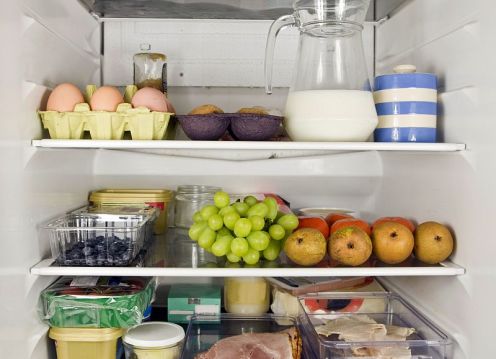
What can be included in a child's diet? Diet No. 5 is gentle, but it cannot be called hungry. Let’s look at what products can be used to create a menu for a child with diseases of the digestive tract.
Flour products and bread
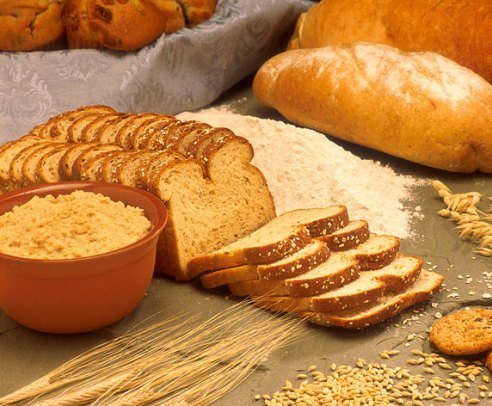
It is allowed to eat dried wheat bread, biscuits, and baked goods based on dry biscuit dough filled with baked apples or cottage cheese.
Prohibited : fresh and rye bread, pastries, cakes and pastries.
First meal
Allowed are vegetarian soups, to which a little cereal (or vermicelli) and cream are added; it is better to prepare them pureed.
Prohibited are dishes prepared with broth (meat, mushroom or fish), vegetable broth and milk, cold soups (okroshka), borscht or cabbage soup. You cannot add millet to the soup.
Meat and fish products
You can eat beef, veal, rabbit, chicken or turkey (without skin), boiled or stewed; you can also prepare steamed cutlets and pureed puree. You can include steamed or boiled whole piece of lean fish in your diet.
It is prohibited to include fatty poultry and meat, sausages, and offal (brains, kidneys, liver) in the diet.
Weekly menu for a sick stomach
For clarity, we have developed a version of a weekly menu based on the principles of diet No. 5.

Monday
Breakfast: “red” buckwheat with beets; pumpkin juice.
Lunch: protein omelet with milk.
Lunch: cauliflower and broccoli soup with meatballs; beef stroganoff with mashed potatoes; fruit liquid jelly.
Snack: oatmeal pancake with cheese.
Dinner: stuffed eggplants in the oven; meringue without cream; still mineral water.
Before bed: 200 ml of fermented baked milk.
Tuesday
Breakfast: couscous with banana slices; chamomile tea.
Lunch: avocado toast; carrot juice.
Lunch: milk noodle soup; tilapia fillet on a bed of vegetables in the oven; apple smoothie.
Snack: ratatouille.
Dinner: meat casserole with buckwheat; natural marmalade; Herb tea.
Before bed: 200 ml of low-fat milk.
Wednesday
Breakfast: rice-semolina porridge; apple banana smoothie.
Lunch: oatmeal cookies with coconut flakes; milk jelly.
Lunch: vegetable cream soup with beef broth; rabbit fricassee with kohlrabi; pear compote.
Snack: lazy dumplings with low-fat cottage cheese.
Dinner: pollock baked on bread with buckwheat; vanilla soufflé; chamomile tea.
Before bed: 200 g of low-fat natural yoghurt.
Thursday
Breakfast: pureed pearl barley porridge with pumpkin; chamomile tea.
Lunch: migliaccio pie; green tea.
Lunch: pike soup; veal dumplings in cream sauce; pear compote.
Snack: Avocado and shrimp salad.
Dinner: turkey and broccoli pie made from savory dough; marshmallows; still mineral water.
Before bed: 200 ml of Varents.
Friday
Breakfast: oatmeal with milk and apple; weak black tea.
Lunch: curd cheese.
Lunch: chicken noodle soup; baked rabbit with potatoes in sour cream; cherry juice
Snack: baked apples with honey.
Dinner: jellied fish in vegetable broth; carrot-beet cutlets; meringues; tea with lemon balm.
Before bed: 200 ml of low-fat kefir.
Saturday
Breakfast: semolina with fruit infusion; diluted black tea.
Lunch: carrot cookies; liquid oatmeal jelly.
Lunch: cheese soup; grenadier fillet with vegetables; dried fruit compote (without berries).
Snack: beet salad with mild feta cheese.
Dinner: lean minced meat pie in omelette filling; fruit and berry jelly; tea with lemon balm.
Before bed: 200 ml of banana milkshake.
Sunday
Breakfast: buckwheat with milk.
Lunch: cheesecakes in the oven; green tea.
Lunch: pumpkin cream soup; chicken hedgehogs; Apple juice.
Snack: fruit salad (apple, strawberry, kiwi, banana).
Dinner: squid stuffed with vegetables; paste; still mineral water.
Before bed: 200 ml of yogurt.
Basic rules of diet No. 5
Dietary nutrition for pancreatitis is not limited to just a list of permitted foods; its recommendations are much broader.
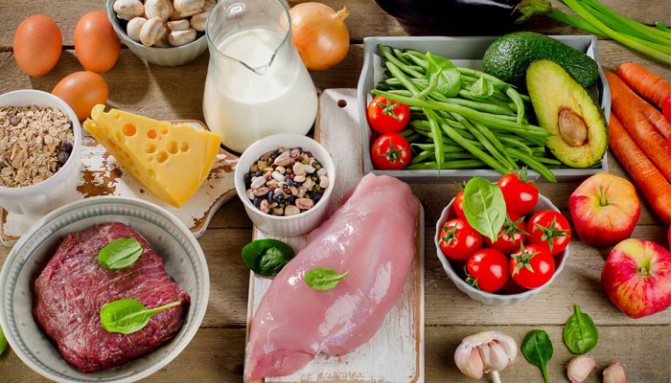
According to diet No. 5, the patient is recommended:
- steam, boil or bake all food without forming a crust;
- It is preferable to eat dishes in the form of purees;
- meat and fish should be cooked by finely chopping and steaming or boiling;
- soups are prepared vegetarian, seasoned with a drop of oil or a spoonful of sour cream before serving;
- Pasta cooked with milk is prohibited;
- milk is allowed for making porridges, soups, jelly;
- all fats must be added to food after cooking, preferably immediately on the plate;
- food should be warm, about 40º C. Cold and hot foods are prohibited;
- limit the daily salt intake;
- ideally avoid sugar or reduce its amount to 80 grams per day;
- eat 5-7 times a day with an interval of 2.5-3 hours. You can consume about 200 grams of food per meal;
- pancreatic insufficiency requires careful selection of products; all of them must be “familiar” to the gland. Experiments with exotic types of food are unacceptable.
Diet 5p: foods from the “green” and “red” lists
| Allowed | Forbidden |
| Stale white bread, crackers and biscuits | Black and fresh bread, pastries, fried pies, pancakes |
| Buckwheat, rice, semolina, oatmeal | Barley, pearl barley, millet |
| Kefir, natural yogurt, low-fat cottage cheese | Fatty dairy products |
| Chicken and turkey meat, rabbit, veal and beef | Lard and meat, lamb, fat, vegetable margarine, offal |
| Boiled doctor's sausage, milk and children's sausages | Smoked meats, cervelat, salami, etc. |
| Ice fish, cod, tuna, hake | Seafood, caviar, salted and fatty fish |
| Homemade pates according to diet No. 5 | Canned food, marinades, mushrooms |
| Parsley, dill, basil, Provençal herbs | Hot spices |
| Casseroles, soufflé | Chips, snacks, croutons |
| Baked fruits, fruit jelly, jelly and puree | Chocolate, candy, cakes, pastries, shelf-stable biscuits |
| Compote, rosehip infusion, chamomile, green tea | Alcohol, sparkling water, coffee, cocoa, strong black tea |
During periods of exacerbation, fruits are prohibited. This limitation also applies to the postoperative period, for example, after removal of the gallbladder . In the cold period of illness, table 5 is expanded by eating seasonal fruits and vegetable salads. Minimal consumption of seeds and nuts is acceptable - crushed in salads. After acute pancreatitis, it is necessary to follow table number 5 for about six months in order to minimize the load on the vulnerable organ.
A selection of recipes
We will describe in more detail the most unusual recipes from the given menu.
Oatmeal pancake with cheese
Using oatmeal you can make healthy pancakes with different filling options. To protect the stomach from the by-products of frying fats, you need to cook them using the “dry” frying method, without adding oil to the pan. Just use a non-stick frying pan.
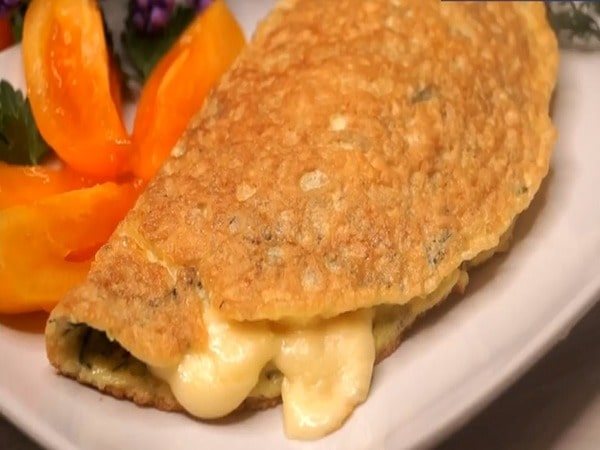
Ingredients:
- 4 tbsp. l. oatmeal;
- 60 ml skim milk;
- 1 egg;
- 50 mg low-fat cheese (Gaudette, Edamer);
- a pinch of salt.
Action plan:
- Pour the cereal into a deep bowl, add a little salt, mix with the egg, and pour in milk.
- Leave for 5 minutes until the oatmeal swells.
- Finely grate the cheese.
- Add 30 g of cheese to the resulting mixture and stir.
- Place the thick mixture onto a heated frying pan and smooth it out with a spatula.
- Cook for 3 minutes on each side.
- While the oatmeal pancake is still hot, sprinkle the remaining cheese so that it melts.
Migliaccio
This is a traditional Neapolitan dessert with ricotta cheese and semolina. In the classic version, 4 eggs are added to the pie. Since yolks in large quantities are contraindicated for the fifth table diet, it is better to take 2 whole eggs, and only whites from the other two. In addition, we replace butter with dietary olive oil and reduce the amount of sugar.
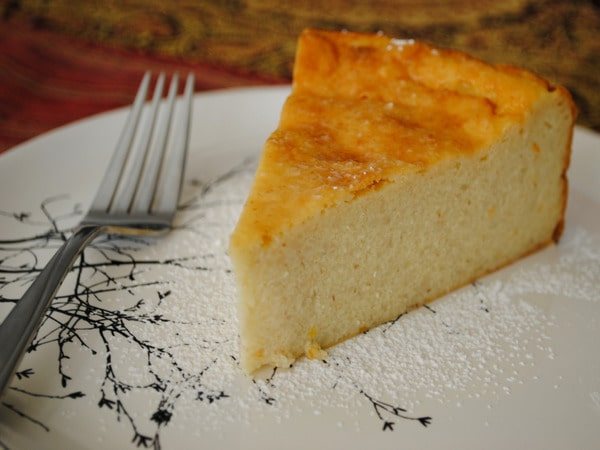
Compound:
- 200 g semolina;
- 200 ml water;
- 500 ml skim milk;
- 4 chicken eggs;
- 350 g ricotta;
- 100 g sugar;
- 40 g olive oil;
- zest of 1 lemon;
- 1 packet of vanilla.
How to cook:
- Remove the zest from the washed lemon.
- Pour milk, water and olive oil into a saucepan, add lemon zest.
- Bring to a boil over medium heat, remove the zest.
- Remove from heat and slowly add semolina, stirring constantly. Add vanillin.
- Separate the whites from the yolks for two eggs, pour the whites into a cup. Break 2 more eggs there whole.
- Add sugar to the eggs and beat well.
- Add ricotta, stir until smooth.
- Mix both semi-liquid masses, place them in a mold and place in an oven preheated to 200˚C.
- Remove from the oven after 50 minutes and cool.
"Red" buckwheat
This dish can be served as a side dish or eaten on its own, for example, for breakfast.

You will need:
- 250 g buckwheat;
- 1 onion;
- 1 beet;
- 2 tbsp. l. olive oil;
- salt to taste.
Recipe:
- Boil the beets and grind in a blender until smooth.
- Cut the onion into small cubes and simmer until transparent.
- Place the buckwheat and onion in a saucepan and add boiling water in a ratio of 1:2.
- Cook over low heat until done.
- Add beets and add a little salt.
- Mix thoroughly and remove from heat after 2 minutes.
Useful video
There are many dietary dishes made from rabbit meat. Ilya Lazerson will talk about the main principles of cooking in the video.
On the one hand, the fifth table is considered less strict than the first. However, the need to limit fats and sugar in the diet, as well as to exclude fixative and choleretic products, significantly narrows the choice of allowed foods. But we know that you can find a way out of any difficult situation! Use your imagination and don’t be afraid to experiment - then you can create a tasty and healthy diet for yourself at the same time.
